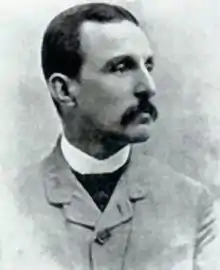Frederick William Stevens
Frederick William Stevens (11 November 1847 – 5 March 1900) was an English architectural engineer who worked for the British colonial government in India.[1] Stevens' most notable design was the railway station Victoria Terminus in Bombay (in 1996, it was renamed the Chhatrapati Shivaji Terminus in Mumbai).[2]
Frederick William Stevens | |
|---|---|
 | |
| Born | 11 November 1847 |
| Died | 5 March 1900 (age 52) |
| Years active | 1870s–1890s |
Stevens also designed the Municipal Corporation Building, Mumbai the Royal Alfred Sailor's Home, the Army and Navy Building at Kala Ghoda, the Post-Office Mews at Apollo Bunder, the head offices of the BB&CI Railway at Churchgate, and the Oriental Life Assurance Offices at the Flora Fountain.[3] He also designed the Rajmahal Palace at Mehsana.[4][5]
He died on 5 March 1900 following malaria and was buried in Sewri Christian Cemetery.

His name and statue can be seen in a scene in the 2006 movie Slumdog Millionaire.
References
- Jeyaraj, George J. "Indo Saracenic Architecture in Channai" (PDF). Chennai Metropolitan Area. Retrieved 30 October 2011.
- "Frederick William Stevens". Mumbai/Bombay pages. 21 July 1997. Retrieved 12 September 2009.
- "Frederick William Stevens". Mumbai Pages . 23 June 2010 <http://theory.tifr.res.in/bombay/persons/fw-stevens.html>.
- Sergeant, Philip W. (1928). The Ruler of Baroda: An Account of the Life and Work of the Maharaja Gaekwar. Albemarle Street, London: John Murray. pp. 226–229.
- Aklekar, Rajendra B. (22 April 2017). "A Sentimental Visit to Mumbai to See Her Great Grandfather's Magnificent Buildings". The Wire. Retrieved 6 November 2020.
court houses at Mehsana for the Gaekwads of Baroda.